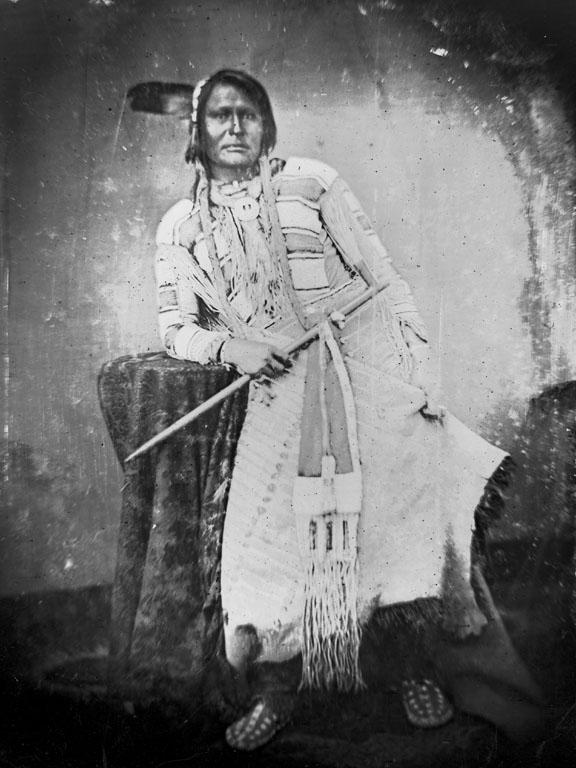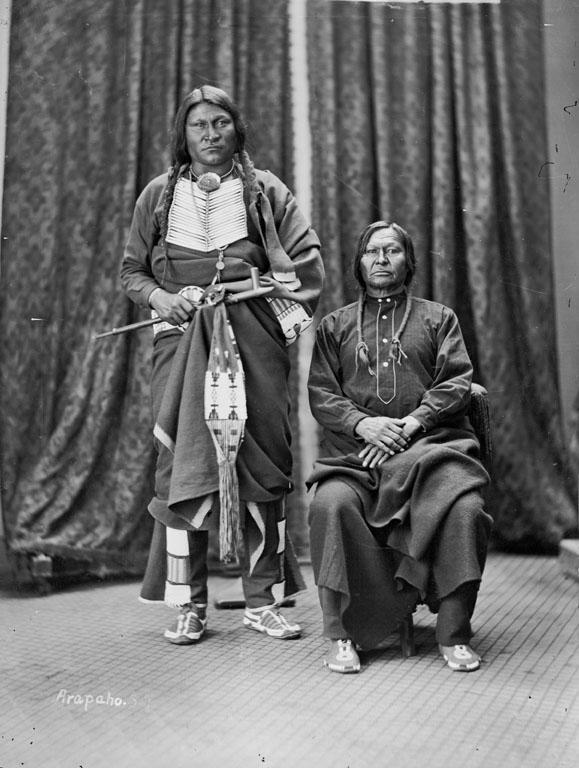The
photograph was taken by Alexander Gardner in November
1873 in Washington, D.C. That year, a delegation of Northern
Cheyenne and Arapaho from the Red Cloud Agency went to
the capitol with their agent, Dr. John J. Saville, to
discuss their hunting rights as well as their future home
(they were concerned about being political marginalized
when placed at an agency with the powerful Lakota). They
met with a delegation of Southern Cheyenne and Arapaho
in Washington and attended meetings together. They appear
to have gone to Gardner's studio together, who produced
a whole series of great Cheyenne and Arapaho portraits.
By
the mid-1870s, Friday's role as an Arapaho leader had
been largely overshadowed by the rise of several younger
men, specifically Black Coal and Sharp Nose. Generally
in the documents of this period, Friday is listed as the
Arapaho interpreter.
—
Ephriam Dickson

Friday,
Arapaho
Friday
and two other Arapahoe boys had become seperated from
their tribe when a fight started at a large intertribal
gathering. Thomas Fitzpatrick, the mountain man, found
the children on the plains, when he was returning from
the Rocky Mountains to St. Louis. He became so fond of
one of the boys (called Warshinun or Black Spot)
that he took him to St. Louis and sent him to school there.
Fitzpatrick named the boy Friday, because he found him
on that day.
He
accompanied Fitzpatrick on several trips west, but one
day a woman in an Arapahoe camp recognized him and claimed
him her son.
From then on he returned to his tribe. Because he learned
English in school he could interpret for his head chiefs
and went to Washington several times. Later he himself
became a band chief, who was always on friendly terms
with the whites.
Here's
a photo of the delegation in 1873:

Crazy
Bull and Friday
—
Dietmar Schulte-Möhring

This
is the same Friday photographed in the 1877 delegation
- or is this picture even later? Where does the name come
from anyhow? He doesn't seem to have aged much in twenty-six
years.
Friday
had several names during his lifetime. As a boy he was
called Black Spot (Warshinun) or Black Coal Ashes.
After a fight with the Pawnees he took one of his father's
names, White Crow. After another fight, this time with
the Shoshones, he took a second name, Thunder.
Finally, after being part of a war party that destroyed
a Ute camp of seven lodges near Bear River, he got the
name “The Man Who Sits in the Corner and Keeps his Mouth
Shut” (also translated shortly as Sits Brooding, "teénokúhú").
“He says that he and a Ute warrior became engaged at close
quarters; the Ute levelled his gun at Friday's breast,
but the cap snapped and in a second Friday had shot hom
through the body and snatched the loaded gun out of his
dying hand.” (John Gregory Bourke)
—
Dietmar Schulte-Möhring